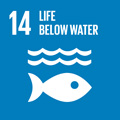- Docente: Daniele Fabbri
- Credits: 6
- SSD: CHIM/01
- Language: Italian
- Moduli: Daniele Fabbri (Modulo 1) Cristian Torri (Modulo 2)
- Teaching Mode: In-person learning (entirely or partially) (Modulo 1); In-person learning (entirely or partially) (Modulo 2)
- Campus: Ravenna
- Corso: Second cycle degree programme (LM) in Science and Technologies for Environmental Sustainability (cod. 6794)
-
from Mar 02, 2026 to Apr 16, 2026
-
from Apr 23, 2026 to May 28, 2026
Learning outcomes
At the end of the course, students have a knowledge of the chemical determinations adopted in the evaluation of environmental quality. They should be able to understand and apply methodologies in chemical environmental monitoring of pollutants in different compartments, criteria to assess the reliability of chemical data and tools for their interpretation in relation to the composition of environmental matrices (air, water, soil/sediment), to the sources of contamination and their effect on the environment.
Course contents
UNIT 1.
- Chemical substances, molecular identity, natural and artificial, additives, byproducts.
- Polycyclic aromatic hydrocarbons.
- Chemical monitoring, sample pre-treatment, solvent extraction, chromatografy/mass spectrometry, evaluation of analytical results, method validation, figures of merit.
- Chemical characteristics of contaminants and matrices, vapour pressure, water solubility, distribution coefficients.
- Dissipation, degradation, photodegradation and ozone formation.
UNIT 2.
- Evaluation of environmental quality: pollution or contamination; environmental quality index and indicators; environmental quality standards; emission standards.
- Combustion pollutants: NOx, SOx, VOC, PMx
- Non-persistent pollutants: COD and BOD, organic load, oxygen balance of surface water bodies, pollution from water discharges, anoxia and dead-zones, hydrocarbons and petroleum.
- Heavy Metals Pollution: Copper, Zinc, Lead, Cadmium, Mercury; sources of pollution, speciation and accumulation in the food chain; the case of Minamata Bay.
- Persistent organic pollutants (POPs): organochlorine insecticides (DDT, HCH), polychlorinated biphenyls (PCB, structure / property relationship, sources), polychlorinated dibenzofurans / dioxins (PCDD / F), combustion pollutants, polybrominated flame retardants, organofluorinated compounds (PFAS).
- Plastics and solid pollution: chemical structure and environmental fate of macro-plastics, micro-plastics and nano-plastics.
- Laboratory activities: analysis of polycyclic aromatic hydrocarbons in water and PM2.5; source accounting through the use of a tracer (levoglucosan).
Readings/Bibliography
Powerpoint presentation accessible in Virtuale.
Documentary sources reported in the slides.
Books available in the Central Library or as e-book:
Manahan, Chimica ambientale, Piccin
Key concepts in Environmental Chemistry G. Hanrahan. Ed. Academic Press
Miller, Statistics and chemometrics for analytical chemistry.
Reports in the website of Eurachem.
Teaching methods
Lecturing, videoprojection, tutorials, utilisation of data base for searching analytical methods (database, ecc), presentation and discussion of case studies from scientific literature or institutional reports, numerical examples. Exercises in a chemical laboratory. All students must attend Module 1, 2 [https://www.unibo.it/en/services-and-opportunities/health-and-assistance/health-and-safety/online-course-on-health-and-safety-in-study-and-internship-areas] online, while Module 3 on health and safety is to be attended in class or on Microsoft Teams according to the modality chosen by the teacher. Information about Module 3 attendance schedule is available on the website of your degree programme.
Assessment methods
Written exam consisting of multiple-choice quiz on the course content and open-ended questions, including the molecular structure of priority pollutants and numerical examples described in the course. There are 15 questions for Module 1 and 13 for Module 2, with a maximum score of +1 for each correct answer. The final score, up to a maximum of 3 points, also includes the evaluation of the laboratory report, which must be submitted before the exam date. Students have 120 minutes for the written exam. Only calculators are permitted during the exam. A minimum score of 18/30 is required to pass the exam.
Students with learning disorders and\or temporary or permanent disabilities: please, contact the office responsible (https://site.unibo.it/studenti-con-disabilita-e-dsa/en/for-students ) as soon as possible so that they can propose acceptable adjustments. The request for adaptation must be submitted in advance (15 days before the exam date) to the lecturer, who will assess the appropriateness of the adjustments, taking into account the teaching objectives.
Teaching tools
Videoprojector. PC. Data base. Chemical laboratory equipments and instrumentations.
Office hours
See the website of Daniele Fabbri
See the website of Cristian Torri
SDGs


This teaching activity contributes to the achievement of the Sustainable Development Goals of the UN 2030 Agenda.
